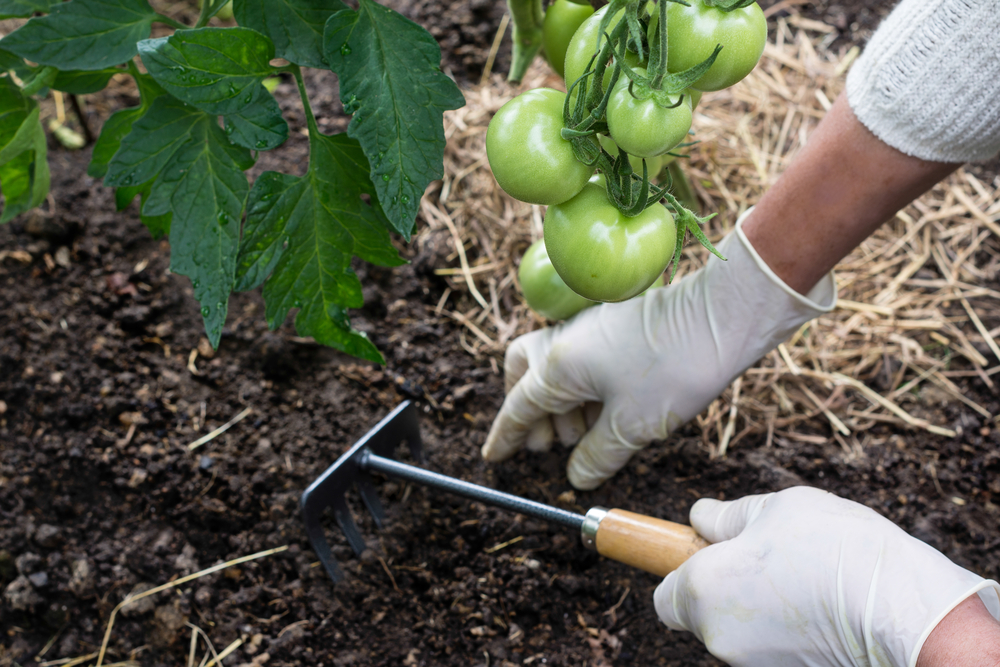Should you mulch your vegetable garden? Well, it can help with such problems as weeds and conserve moisture.
But what you use on a vegetable garden is almost as important as what you put in it. Here are some options:
Black Plastic–Black plastic mulch can warm the soil. Earlier in the spring, around the end of April, it can help to keep the soil warmer around the roots of things like tomatoes, peppers, and eggplants, which like warm soil. On the other hand, that’s not a great idea in July and August. And it does not allow water through—another consideration. My problem with it is that it is not biodegradable and ends up with all the other plastic in landfills at some point.
Grass Clippings—Grass clippings are free—available whenever you mow your lawn. They are biodegradable and do allow water through. Disadvantages? Well, it depends on how you treat your lawn. If your grass hasn’t been grown with chemical weed-killers or pesticides, then use it. If it has—then think about all those nice chemicals leaching into the soil around your plants…
Dried Leaves—Dried leaves are another freebie. They allow moisture through and can keep soil cooler, so are best applied later—once the soil has warmed up–around June. They are biodegradable and can be tilled at the end of the season. Run them over with the lawn mower first to chop them up. The disadvantage: they can blow away on a windy day. Do not use leaves from black walnut trees as they produce a substance that is toxic to tomato family members.
Straw—Same advantages as grass clippings. Disadvantages: You have to buy it. Regular straw is good for vegetable gardens, however, pine straw can acidify the soil so should be used for plants that like acidic soil—azaleas, blueberries, etc.
Bark Mulch—Pine bark mulch can also acidify soil so you may want to have your soil tested before and after applying. Some hardwood mulch may contain bigger chunks of wood and those take longer than one season to decompose. Don’t use colored or dyed mulch.
Newspapers—Yes, you can use sheets of newspaper as mulch. Use 2 to 4 sheets. Wet it thoroughly after you lay it down. Do not use pages with colored inks as colored inks can contain lead and other chemicals. You may want to put a little bark mulch on top to anchor it.
All of the above could give earwigs or slugs a place to hide, so keep an eye out.
Compost—using compost as mulch adds organic nutrients to the soil. Disadvantages—well, since it’s a lot like soil, weed seeds can grow in it.
Doing Nothing—Advantages: It’s easy to tell when the soil around your plants is dry. Easy to apply plant food, requires no money or extra work. Disadvantages: You do have to weed. And you’ll still want to add some compost at season’s end to provide fresh nutrients for next season’s garden.
Whichever mulch you go for, timing is important. Do make sure that seedlings are at least four to six inches tall before mulching around them. If you choose to use plastic mulch, you may want to take it up in July to keep it from keeping the soil too warm. Do not use loose mulches like grass clippings, straw, or leaves until June to allow the sun to warm the soil first. And keep mulch a couple of inches away from the stems of plants as stems can rot if kept too damp.
If your garden is big enough to need a walkway through it, then keep that in mind when selecting mulch.
Over the years I’ve tried most of the above (except the plastic). The one I prefer is using leaves. If I’m lucky enough to have some left over from the previous fall, so much the better. That gives them a chance to start to break down a little over the winter. By the end of the next summer, they are perfect to till under when the garden is done.

